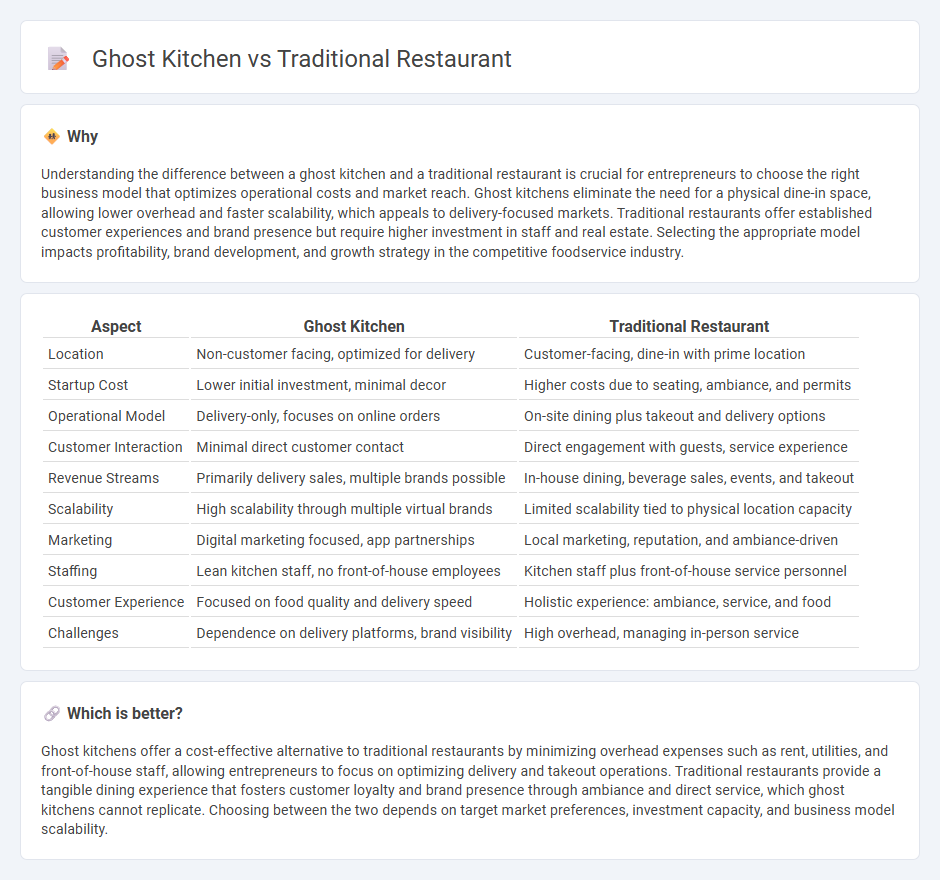
Ghost kitchens operate without a physical dining space, focusing solely on delivery and takeout services, which drastically reduces overhead costs compared to traditional restaurants. Traditional restaurants invest heavily in ambiance, front-of-house staff, and in-person dining experience, appealing to customers seeking a social atmosphere. Explore the dynamics between ghost kitchens and traditional restaurants to understand which model best suits emerging entrepreneurs.
Why it is important
Understanding the difference between a ghost kitchen and a traditional restaurant is crucial for entrepreneurs to choose the right business model that optimizes operational costs and market reach. Ghost kitchens eliminate the need for a physical dine-in space, allowing lower overhead and faster scalability, which appeals to delivery-focused markets. Traditional restaurants offer established customer experiences and brand presence but require higher investment in staff and real estate. Selecting the appropriate model impacts profitability, brand development, and growth strategy in the competitive foodservice industry.
Comparison Table
| Aspect | Ghost Kitchen | Traditional Restaurant |
|---|---|---|
| Location | Non-customer facing, optimized for delivery | Customer-facing, dine-in with prime location |
| Startup Cost | Lower initial investment, minimal decor | Higher costs due to seating, ambiance, and permits |
| Operational Model | Delivery-only, focuses on online orders | On-site dining plus takeout and delivery options |
| Customer Interaction | Minimal direct customer contact | Direct engagement with guests, service experience |
| Revenue Streams | Primarily delivery sales, multiple brands possible | In-house dining, beverage sales, events, and takeout |
| Scalability | High scalability through multiple virtual brands | Limited scalability tied to physical location capacity |
| Marketing | Digital marketing focused, app partnerships | Local marketing, reputation, and ambiance-driven |
| Staffing | Lean kitchen staff, no front-of-house employees | Kitchen staff plus front-of-house service personnel |
| Customer Experience | Focused on food quality and delivery speed | Holistic experience: ambiance, service, and food |
| Challenges | Dependence on delivery platforms, brand visibility | High overhead, managing in-person service |
Which is better?
Ghost kitchens offer a cost-effective alternative to traditional restaurants by minimizing overhead expenses such as rent, utilities, and front-of-house staff, allowing entrepreneurs to focus on optimizing delivery and takeout operations. Traditional restaurants provide a tangible dining experience that fosters customer loyalty and brand presence through ambiance and direct service, which ghost kitchens cannot replicate. Choosing between the two depends on target market preferences, investment capacity, and business model scalability.
Connection
Ghost kitchens and traditional restaurants are interconnected through shared operational elements such as menu development, food preparation, and customer data analysis. Both business models leverage digital ordering platforms and delivery services to reach consumers, enhancing market reach without expanding physical dine-in space. The rise of ghost kitchens complements traditional restaurants by reducing overhead costs and enabling experimentation with new cuisines, thereby diversifying revenue streams within the foodservice industry.
Key Terms
Brick-and-Mortar
Traditional brick-and-mortar restaurants offer customers a tangible dining experience with ambient ambiance, personalized service, and immediate food presentation, contributing to brand loyalty and local community engagement. These establishments incur higher operational costs due to rent, utilities, and front-of-house staff, impacting profit margins compared to ghost kitchens that operate exclusively online without dine-in space. Explore the detailed advantages and challenges of both models to understand their impact on the evolving foodservice industry.
Delivery-Only
Traditional restaurants offer a full dining experience with on-site seating, while ghost kitchens operate exclusively for delivery, reducing overhead costs and optimizing food preparation for speed and efficiency. Ghost kitchens leverage advanced technology and strategic location choices to maximize delivery reach and minimize wait times. Explore more to understand how delivery-only models are reshaping the food industry landscape.
Overhead Costs
Traditional restaurants face high overhead costs including rent, utilities, staff wages, and front-of-house maintenance, often accounting for up to 60% of expenses. Ghost kitchens operate with significantly lower overhead by eliminating dine-in space and reducing staff, resulting in cost savings that can improve profit margins by 20-30%. Explore how these differences impact overall business sustainability and growth potential.
Source and External Links
Classic Tallahassee Restaurants - Features traditional restaurants known for steaks, seafood, Cajun, and Southern cooking in a historic and casual atmosphere dating back decades.
Hayward House: Where History Meets Modern Elegance - A restaurant blending traditional age-old recipes with modern dining in downtown Tallahassee, emphasizing fresh ingredients and heritage flavors.
Taste of Tallahassee - Showcases traditional Southern cuisine from longtime local eateries serving classic dishes like fried chicken, pork chops, shrimp and grits, and soul food favorites.
 dowidth.com
dowidth.com